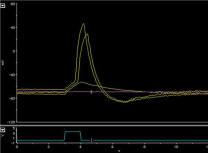About the
The Do-It-Yourself Neuron

Ohm's Law, Kirchoff's Current Laws, and the electronic "equivalent circuit model" are standard tools for explaining the central physiological properties of neurons and neuronal membranes in terms of simple electronic components and circuits. However, most introductory neuroscience students who are presented with these tools have had little or no prior exposure to electronics. Electronic formulas and circuit diagrams presented as theoretical constructs are of little practical use to them in understanding and predicting neuronal behavior.
The Do-It-Yourself Neuron (DIYN) addresses three common problems in the introductory neurophysiology course:
1) Electrical laws and electronic equivalent circuits are central theoretical constructs in explaining neuronal behavior,
but
often make less intuitive sense to students than do the phenomena they are invoked to explain.
2) In vivo and in vitro laboratory exercises provide practical applications of classroom concepts,
but
require the student to simultaneously master surgical techniques, micromanipulation, complex electronic instrumentation, and theoretical concepts in a time-critical setting.
3) Computer simulations provide rapid, convenient, reproducible results,
but
may allow students to simply "twiddle" parameters without mastering the underlying concepts.
Hardware models can effectively bridge between conventional "wet" and computer lab exercises. In particular they offer the following advantages:
1) They are durable, reusable, and cheap (generally under $50 to construct - see below).
2) They use much of the same data collection instrumentation (e.g. cables, amplifiers, stimulators, computers) as recording from living tissue. This familiarizes the student with this instrumentation prior to applying it to time-critical in vivo or in vitro recording.
3) They provide practical insight into unfamiliar properties of both neurons (e.g. membrane capacitance, current spread) and recording instrumentation (e.g. signal filtering, impedance matching).
4) They provide consistent, reproducible results and a respite from the demands and frustrations of working with living preparations.
5) They can be successfully adapted for use at all levels of instruction, from middle-school science campers to neurobiology students to college English professors.
The Do-It-Yourself Neuron currently includes hardware boards and associated exercises for studying properties of RC filters and membrane patches, resistor-ladder and RC cable properties involved in membrane current spread, current flow across electrical synapses, and action potential gating kinetics.
Each DIYN board takes from 1 to 3 hours to build. Approximate materials costs for construction of the various DIYN boards are:
RCSCM - $20 GECM - $50 (+ $90 for three DC power adapters)
RCTM, RLCPM - $25 CECM - $60 (+ $90 for three DC power adapters)
RCCPM - $60 (set of three boards)
BIO325 Neurobiology is a laboratory-based introduction to cellular-to-systems level neurobiology, focusing on traditional electrophysiological methods. It combines and interweaves DIYN laboratory exercises with exercises from two other sources: invertebrate "wet" labs primarily from Crawdad, A CD-ROM Manual for Neurophysiology and computer simulations from Neurons in Action 2: Tutorials and Simulations Using Neuron.
A more detailed description of the DIYN project and samples of student-generated results are available online in a poster (PowerPoint format) or upon request from brhoades@wesleyancollege.edu .
Development of the models and course exercises of the Do-It-Yourself Neuron was supported by funds from the Munroe family of Georgia and NSF DUE/CCLI grant #9950546.





